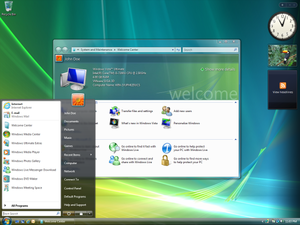OS X El Capitan: 10.11.6: OS X Yosemite: 10.10.5: OS X Mavericks: 10.9.5: OS X Mountain Lion: 10.8.5: OS X Lion: 10.7.5: Mac OS X Snow Leopard: 10.6.8: Mac OS X Leopard: 10.5.8: Mac OS X Tiger: 10.4.11: Mac OS X Panther: 10.3.9: Mac OS X Jaguar: 10.2.8: Mac OS X Puma: 10.1.5: Mac OS X Cheetah: 10.0.4. An operating system (OS) is a collection of software that manages computer hardware resources and provides common services for computer programs. The operating system is a vital component of the system software in a computer system. This tutorial will take you through step by step approach while learning Operating System concepts. The Mac system overview panel will appear on screen, showing what Mac OS release and version is installed on the computer In the this screenshot example, the “About This Mac” screen on that particular Mac is running “macOS Mojave” as the major release, and the specific version of MacOS Mojave that is running is 10.14.2. MacOS Sierra or High Sierra: MacBook Pro from mid 2010 or later; OS X Lion or later (Mountain Lion in the case of High Sierra) OS X El Capitan: MacBook Pro from mid 2007 or later; OS X Snow Leopard or later; OS X Yosemite: MacBook Pro from mid 2006 or later; OS X Snow Leopard or later. Note: The headings on this list indicate the Macintosh System bundle names; the bullet points indicate the version of the System File included in that bundle. This is to make it clearer for people searching for specific bundle versions as opposed to System File versions. Finder File versions are not indicated. 1 Classic Mac OS 1.1 Macintosh System Software (0 - 0.3) 1.1.1 System File 1 1.1.2.


List Of Computer Os For Mac From 2010 Till Present Time
| Year | Event |
|---|---|
| 1978 | In June 1978, Apple introduced Apple DOS 3.1, the first operating system for the Apple computers. |
| 1984 | Apple introduced System 1 in 1984. |
| 1985 | Apple introduced System 2 in 1985. |
| 1986 | Apple introduced System 3 in 1986. |
| 1987 | Apple introduced System 4 in 1987. |
| 1988 | Apple introduced System 6 in 1988. |
| 1991 | Apple introduced System 7 operating system on May 13, 1991. |
| 1995 | Apple allowed other computer companies to clone its computer by announcing it licensed the Macintosh operating system rights to Radius on January 4. |
| 1997 | Apple introduced macOS 8 in 1997. |
| 1997 | Apple bought NeXT Software Inc. for $400 million and acquired Steve Jobs, Apple co-founder, as a consultant. |
| 1999 | Apple introduced macOS 9 in 1999. |
| 1999 | Apple released macOS X Server 1.0 on March 16, 1999. |
| 2001 | Apple introduced macOS X 10.0, code-named Cheetah, and became available on March 24, 2001. |
| 2001 | Apple introduced macOS X 10.1, code-named Puma, and became available on September 25, 2001. |
| 2002 | Apple introduced macOS X 10.2, code-named Jaguar, and became available on August 23, 2002. |
| 2003 | Apple introduced macOS X 10.3, code-named Panther, on October 25, 2003. |
| 2004 | Apple introduced macOS X 10.4, code-named Tiger, at the WWDC on June 28, 2004. |
| 2007 | Apple introduced macOS X 10.5, code-named Leopard, on October 26, 2007. |
| 2008 | Apple introduced MobileMe at the WWDC on June 9, 2008. |
| 2009 | Apple introduced macOS X 10.6, code-named Snow Leopard, at the WWDC on June 8, 2009. |
| 2010 | Apple introduced macOS X 10.7, code-named Lion, at the 'Back to the Mac' event on October 20, 2010. The operating system was later released on July 20, 2011. New features included AirDrop, Gatekeeper, and many more. |
| 2012 | Apple released macOS X 10.8, code-named Mountain Lion, on July 25, 2012. |
| 2013 | Apple introduced macOS X 10.9, code-named Mavericks, at the WWDC on June 10, 2013. |
| 2014 | Apple introduced macOS X 10.10, code-named Yosemite, at the WWDC on June 2, 2014. Yosemite was later released on October 16, 2014. |
| 2014 | Apple introduced Force Touch, a haptic feedback system for macOS. Simultaneously, they launch a similar feedback system for iOS called 3D Touch. |
| 2015 | Apple introduced macOS X 10.11, code-named El Capitan, at the WWDC on June 8, 2015. |
| 2016 | Apple introduced macOS X 10.12, code-named Sierra, at the WWDC on June 13, 2016. |
| 2017 | Apple introduced macOS X 10.13, code-named High Sierra, at the WWDC on June 5, 2017. |
| 2018 | Apple introduced macOS X 10.14, code-named Mojave, at the WWDC on June 4, 2018. |
| 2018 | Apple introduced Dark Mode in macOS X 10.14 (Mojave), a feature that turns the background to black and text to white. Dark Mode is easier on users' eyes at night, reducing eye strain. |
| 2019 | Apple introduced macOS X 10.15, code-named Catalina, at the WWDC on June 3, 2019. |

Comments are closed.